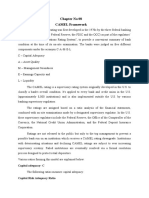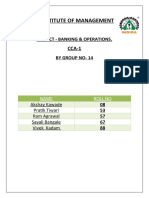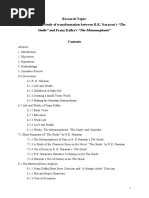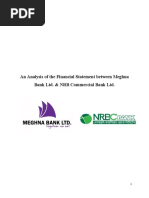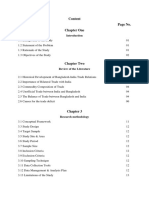4.1.1 Ratio of Interest Income To Total Assets: 4.1 Analysis
Uploaded by
Golam Samdanee Taneem4.1.1 Ratio of Interest Income To Total Assets: 4.1 Analysis
Uploaded by
Golam Samdanee Taneem4.
1 Analysis
4.1.1 Ratio of Interest Income to Total Assets:
The "Interest income to total assets ratio" reflect banks' reliance
on interest from bank lending as a source of funding. A high ratio is a good
indicator (but a too high ratio is not necessarily a good indicator), while a
low ratio might indicate that banks rely on non-interest source of funds.
(Source: intellectualresearch.com)
Interest Earned
Interest Income to Total Assets = × 100
Total Assests
Table 4.1.1: Ratio of Interest Income to Total Assets:
Bank/ Year 2017 2018 2019
Sonali Bank Limited 2.20 2.50 2.80
Rupali Bank Limited 6.10 5.14 5.32
Agrani Bank Limited 5.89 6.59 6.20
Janata Bank Limited 5.02 3.98 3.72
Source: Annual Reports of SBL, RBL, ABL, JBL, BBL and BDBL (2017-2019)
Graphical Presentation:
Ratio of Interest Income to Total Assests
6.59
7 6.1 6.2
5.89
6 5.14 5.32 5.02
5 3.98
3.72
4
2.8
2.5
3 2.2
2
1
0
Sonali Bank Limited Rupali Bank Agrani Bank Janata Bank
Limited Limited Limited
2017 2018 2019
Chart 4.1.1: Ratio of Interest Income to Total Assets
Interpretation:
The presenting graph clarified the highest the higher this ratio the better indicating the bank is
earning a high interest rate or the proportion of interest earning assets (loans) to total assets is
high or both of these effects. This ratio showing that, Agrani Bank earned a highest interest rate
in 2008. In the year of 2007, Rupali bank earned highest interest income than the other
commercial banks. This ratio refers the lowest interest rate earner as Sonali Bank Limited from
the year of 2017 to 2019. Too high of interest income to total assets ratio would be attributed to
the high interest income (rate) derived from high risk loans (subject to default). Also, if the high
interest income is being generated by too high a proportion of assets in loans that could stem
from lack of liquidity. That is, the bank should have a reasonable amount of cash and cash like
securities (easily converted to cash such as Treasury bills) as part of their total assets to meet
withdrawal needs. If the interest income to total assets ratio is too low that usually is from
earning low interest income (rate) and/or too little lending.
4.1.2 Ratio of Securities of Total Assets:
(Marketable Securities+Cash)
Ratio of Securities of Total Assets =
Current Liabilities
Bank/ Year 2017 2018 2019
Sonali Bank Limited 0.11 0.13 0.08
Rupali Bank Limited 0.14 0.10 0.29
Agrani Bank Limited 0.37 0.28 0.57
Janata Bank Limited 1.45 0.07 6.68
4.1.2 Securities of Total Assets
Securities of Total Assets
6.68
7
6
5
4
3 1.45
2 0.370.280.57
0.110.130.08 0.14 0.1 0.29 0.07
1
0
Sonali Bank Rupali Bank Agrani Bank Janata Bank
Limited Limited Limited Limited
2017 2018 2019
The cash asset ratio is the current value of marketable securities and cash,
divided by the company's current liabilities. Also known as the cash ratio, the
cash asset ratio compares the amount of highly liquid assets (such as cash and
marketable securities) to the amount of short-term liabilities. This figure is used to
measure a firm's liquidity or its ability to pay its short-term obligations.
4.1.3 Ratio of Earning Assets to Total Assets:
Avg . Earning Assests
Ratio of Earning Assets to Total Assets =
Avg .Total Assets
Bank/ Year 2017 2018 2019
Sonali Bank Limited 0.021947539 0.0230497 0.02611021
Rupali Bank Limited 0.0594165 0.0574069 0.05210022
Agrani Bank Limited 0.375782206 0.287728 0.57596832
Janata Bank Limited 0.049304468 0.0441792 0.05165268
Ratio of Earning Assets to Total Assets
0.6
0.5
0.4
0.3
0.2
0.1
0
Sonali Bank Rupali Bank Agrani Bank Janata Bank
Limited Limited Limited Limited
2017 2018 2019
The earning assets to total assets ratio is a formula that banks commonly use to
evaluate the proportion of a company's assets that are actively generating
income. It provides the bank—or any individual investor—with insight into how
likely the company is to generate a profit.
4.1.4 Ratio of Current Deposits to Total Liabilities:
A large base of retail deposits would be evidenced by a high total deposit ratio.
Total customer deposits
Ratio of Current Deposits to Total Liabilities =
Total assets
Bank/ Year 2017 2018 2019
Sonali Bank Limited 0.84 2.6 2.6
Rupali Bank Limited 0.82 0.83 0.83
Agrani Bank Limited 0.78 0.78 0.08
Janata Bank Limited 0.8 0.78 0.77
Ratio of Current Deposits to Total Assets
3 2.6 2.6
2.5
1.5
0.84 0.82 0.83 0.83 0.78 0.78 0.8 0.78 0.77
1
0.5 0.08
0
Sonali Bank Rupali Bank Agrani Bank Janata Bank
Limited Limited Limited Limited
2017 2018 2019
4.1.4 Current Deposits to Total Liabilities
Liability liquidity refers to the ease with which a bank can obtain new debt to acquire cash assets
at low reasonable cost. A potential lender to a bank will look at the loan performance, capital
base and the composition of the outstanding deposits and other liabilities of the Bank.
The higher the total deposit ratio, the lower is the perceived liquidity risk because contrary to
purchased funds, retail deposits are less sensitive to a change in interest rates or a minor
deterioration in business performance.
4.1.5 Ratio of Bank Capital to Total Assets:
T 1∧T 2 Capital
Ratio of Bank Capital to Total Assets =
Total Assets
2017 2018 2019
Sonali Bank
0.34 0.17
Limited 0.88
Rupali Bank
0.83 0.8 0.73
Limited
Agrani Bank
1.4 0.49 0.37
Limited
Janata Bank
2.54 1.23 1.9
Limited
Bank Capital to Total Assets
3 2.54
2.5
1.9
2
1.4
1.5 1.23
0.88 0.83 0.8 0.73
1
0.49
0.34 0.37
0.5 0.17
0
Sonali Bank Rupali Bank Agrani Bank Janata Bank
Limited Limited Limited Limited
2017 2018 2019
The Bank Capital-to-Total Assets ratio calculates a banks assets and capital to determine whether
there is enough capital to cover the assets, expressed as a percentage. In banking, the capital-to-
asset ratios are used in several ways, including the variable capital asset ratio and capital
adequacy ratio (CAR).
The variable capital asset ratio is a method of credit control. Set by the central bank – a
“banker’s bank” that manages the country’s finances – the variable capital asset ratio applies to
commercial banks and determines the ratio of capital a commercial bank should have to its total
assets.
4.1.6 Ratio of Per Employee Assets:
Total Assets
Assets Per Employee =
Total Full−Time Employee
2017 2018 2019
Sonali Bank 7.27 7.56 8.52
Limited
Rupali Bank
6.78 8.25 8.86
Limited
Agrani Bank
3.044147523 3.7024336 4.49008381
Limited
Assets Per Employee
4.49
2019 8.86
8.52
3.7
2018 8.25
7.56
3.04
2017 6.78
7.27
0 1 2 3 4 5 6 7 8 9 10
Sonali Bank Limited Rupali Bank Limited Agrani Bank Limited
The assets per employee ratio reflects the amount of assets a credit union holds per each full-time
employee. The metric is an effective measure of productivity as credit unions derive the bulk of
their incomes from their assets.
4.1.7 Ratio of Salaries and Allowances per Employee:
Salaries and Allowances Per Employee =
(Basic + HRA + Transport Allowances + FBP Allowances + Bonus) – (Provident
Fund – Income Tax – Insurance)
Bank/ Year 2017 2018 2019
Sonali Bank Limited 36,819.80 35,128.01 33,668.47
Rupali Bank Limited - - -
Agrani Bank Limited 10,148.06 10,540.33 10,452.00
Janata Bank Limited
4.1.8 Ratio of Loan and Advances to Total Assets:
Loan and advances are the major component in the total working fund (total assets), which
indicates the ability of bank to utilize its deposits in the form of loan and advances to earn high
return. The ratio is calculated as below:
Loan∧ Advanves
Loan & Advances to Total Assets Ratio =
Total Assets
2017 2018 2019
Sonali Bank
0.018 0.0375
Limited 0.019
Rupali Bank
0.66 0.68 0.65
Limited
Agrani Bank
0.003 0.0023 0.0044
Limited
Janata Bank
0.055 0.0616 0.0612
Limited
Loan and Advances to Total Assets (%)
0.7
0.6
0.5
0.4
0.3
0.2
0.1
0
Sonali Bank Rupali Bank Agrani Bank Janata Bank
Limited Limited Limited Limited
2017 2018 2019
From the above table and figure, it is clear that the loan and advances to total assets
ratio of banks have been regular throughout the study period with only slight
fluctuations.
4.1.9 Ratio of Interest Expenses to Total Assets:
The interest expense ratio is calculated by dividing total interest expense on all loans for one
fiscal or calendar year by the earnings before interest, income taxes, depreciation or amortization
(commonly referred to as EBITDA).
Total Interest Expenses
Interest Expenses to Total Assets =
EBITDA
In a balanced use of the 100% of the EBITDA funds available to a business,
The interest expense ratio should be no more than 25 percent
Owner draws should be 25 percent or less
Term loan principal payments should be 25 percent or less
The remaining 25 percent or more is available for asset purchases.
You might also like
- Regional Rural Banks of India: Evolution, Performance and ManagementFrom EverandRegional Rural Banks of India: Evolution, Performance and ManagementNo ratings yet
- 12 Chapter - Ii Results and Analysis Data Presentation and AnalysisNo ratings yet12 Chapter - Ii Results and Analysis Data Presentation and Analysis18 pages
- Financial analysis of banking companiesNo ratings yetFinancial analysis of banking companies17 pages
- Banking Concepts: Cash Reserve Ratio (CRR)No ratings yetBanking Concepts: Cash Reserve Ratio (CRR)18 pages
- How Are Banking Ratios Compiled ?: Business EducationNo ratings yetHow Are Banking Ratios Compiled ?: Business Education4 pages
- Net Income (Interest Received - Interest Paid) Average Assets Invested (Advances + Investements + - Balance With RBI) RatioNo ratings yetNet Income (Interest Received - Interest Paid) Average Assets Invested (Advances + Investements + - Balance With RBI) Ratio5 pages
- Shreya Jain - PGFC1935 - Performance AnalysisNo ratings yetShreya Jain - PGFC1935 - Performance Analysis13 pages
- Important Ratios For Banks: Sumit Puri (56) Tamal Bhattacharya (47) Namit ManglaniNo ratings yetImportant Ratios For Banks: Sumit Puri (56) Tamal Bhattacharya (47) Namit Manglani41 pages
- CAMEL Rating With Analysis and DiscussionNo ratings yetCAMEL Rating With Analysis and Discussion10 pages
- (VIII) Chapter 3 (Financial Analysis and SWOT Analysis)No ratings yet(VIII) Chapter 3 (Financial Analysis and SWOT Analysis)14 pages
- Banking Ratio Financial Statement AnalysisNo ratings yetBanking Ratio Financial Statement Analysis9 pages
- 1 Ratio Analysis:: Capital Adequacy RatiosNo ratings yet1 Ratio Analysis:: Capital Adequacy Ratios5 pages
- An Insight On The Financials of The 3 Largest Public Sector Bank in India Presented By: Group 8 Section A Mba-Jan 13No ratings yetAn Insight On The Financials of The 3 Largest Public Sector Bank in India Presented By: Group 8 Section A Mba-Jan 1322 pages
- Bank Management Term Paper: Quantitative Factor AnalysisNo ratings yetBank Management Term Paper: Quantitative Factor Analysis17 pages
- Chap IV Analyzing Commercial Bank PerformanceNo ratings yetChap IV Analyzing Commercial Bank Performance29 pages
- Bank Performance Analysis - Sahil Badaya PGFB1942No ratings yetBank Performance Analysis - Sahil Badaya PGFB194210 pages
- Key Financial Indicators in The Banking SectorNo ratings yetKey Financial Indicators in The Banking Sector3 pages
- Bank Performance Analysis With Risk RatiosNo ratings yetBank Performance Analysis With Risk Ratios8 pages
- Chapter No 08 CAMEL Framework: Capital Adequacy-CNo ratings yetChapter No 08 CAMEL Framework: Capital Adequacy-C10 pages
- Submitted By: Anmol Hindwani (Pgsf1907) : Bank Performance AnalysisNo ratings yetSubmitted By: Anmol Hindwani (Pgsf1907) : Bank Performance Analysis20 pages
- Report Analysis SIDBI - 2016-2018 - : Vivek V Indian Institute of Management, KashipurNo ratings yetReport Analysis SIDBI - 2016-2018 - : Vivek V Indian Institute of Management, Kashipur12 pages
- FI - Summer 2022 - PPT Slides - Banking RatiosNo ratings yetFI - Summer 2022 - PPT Slides - Banking Ratios34 pages
- Commercial Banking: Analyzing Bank PerformanceNo ratings yetCommercial Banking: Analyzing Bank Performance21 pages
- Indira Institute of Management: Subject - Banking & OperationsNo ratings yetIndira Institute of Management: Subject - Banking & Operations18 pages
- Financial Ratio Analysis: Some Key RatiosNo ratings yetFinancial Ratio Analysis: Some Key Ratios2 pages
- Research Topic: Disaster Management in Shatkhira During AmphanNo ratings yetResearch Topic: Disaster Management in Shatkhira During Amphan39 pages
- Southeast University: Research Monograph On "A Critical Analysis of Artho Rin Adalot Ain, 2003"No ratings yetSoutheast University: Research Monograph On "A Critical Analysis of Artho Rin Adalot Ain, 2003"1 page
- Evsjv 'K Pjw"Pî I Uwjwfkb Bbw÷Wudu Cö - Vebv: C Vgvy Wpî WBG©VBNo ratings yetEvsjv 'K Pjw"Pî I Uwjwfkb Bbw÷Wudu Cö - Vebv: C Vgvy Wpî WBG©VB9 pages
- Page No. Chapter One General IntroductionNo ratings yetPage No. Chapter One General Introduction2 pages
- Research Title: Violence Against Children in Bangladehs: AcknowledgementNo ratings yetResearch Title: Violence Against Children in Bangladehs: Acknowledgement3 pages
- Makalah Tentang Inovasi Dan Perubahan OrganisasiNo ratings yetMakalah Tentang Inovasi Dan Perubahan Organisasi16 pages
- Your English Pal ESL Lesson Plan Cost of Living Crisis Student v1No ratings yetYour English Pal ESL Lesson Plan Cost of Living Crisis Student v14 pages
- SUMMARY - SUKARMAN - A062201008 - An Empirical Evaluation of Accounting Income NumberNo ratings yetSUMMARY - SUKARMAN - A062201008 - An Empirical Evaluation of Accounting Income Number3 pages
- Komin Et Al 2020 COVID 19 and Its Impact On Informal Sector Workers A Case Study of ThailandNo ratings yetKomin Et Al 2020 COVID 19 and Its Impact On Informal Sector Workers A Case Study of Thailand10 pages
- History of Microfinance and Comparison of Grameen Bank and BancosolNo ratings yetHistory of Microfinance and Comparison of Grameen Bank and Bancosol26 pages
- List of Non Remitting And/Or Non Reporting Employers: NO PRO PEN Employer'S NameNo ratings yetList of Non Remitting And/Or Non Reporting Employers: NO PRO PEN Employer'S Name90 pages
- Mahatma Jyotiba Phule Rohilkhand University, Bareilly: Father's/Mother's Name: VIVEKANAND/SADHNANo ratings yetMahatma Jyotiba Phule Rohilkhand University, Bareilly: Father's/Mother's Name: VIVEKANAND/SADHNA1 page
- GST 223, Q&a (Kadung Samuel For Sossa 001 2019)100% (1)GST 223, Q&a (Kadung Samuel For Sossa 001 2019)66 pages
- SAIL JO Manual 2022 - General Functional ManagementNo ratings yetSAIL JO Manual 2022 - General Functional Management162 pages
- Appointment Letter-Contract: National Highway Authority of India100% (1)Appointment Letter-Contract: National Highway Authority of India2 pages
- Minggu 11 Chapter 14 Inflation and Price ChangeNo ratings yetMinggu 11 Chapter 14 Inflation and Price Change29 pages
- Forex For Beginners: "Rapid Quick Start Manual" by Brian CampbellNo ratings yetForex For Beginners: "Rapid Quick Start Manual" by Brian Campbell10 pages
- Lesson 3 - Accounting Equation - For StudentsNo ratings yetLesson 3 - Accounting Equation - For Students39 pages
- Developers Share More Plans About Northgate's Next High-Rise PropertyNo ratings yetDevelopers Share More Plans About Northgate's Next High-Rise Property2 pages
- Regional Rural Banks of India: Evolution, Performance and ManagementFrom EverandRegional Rural Banks of India: Evolution, Performance and Management
- 12 Chapter - Ii Results and Analysis Data Presentation and Analysis12 Chapter - Ii Results and Analysis Data Presentation and Analysis
- How Are Banking Ratios Compiled ?: Business EducationHow Are Banking Ratios Compiled ?: Business Education
- Net Income (Interest Received - Interest Paid) Average Assets Invested (Advances + Investements + - Balance With RBI) RatioNet Income (Interest Received - Interest Paid) Average Assets Invested (Advances + Investements + - Balance With RBI) Ratio
- Important Ratios For Banks: Sumit Puri (56) Tamal Bhattacharya (47) Namit ManglaniImportant Ratios For Banks: Sumit Puri (56) Tamal Bhattacharya (47) Namit Manglani
- (VIII) Chapter 3 (Financial Analysis and SWOT Analysis)(VIII) Chapter 3 (Financial Analysis and SWOT Analysis)
- An Insight On The Financials of The 3 Largest Public Sector Bank in India Presented By: Group 8 Section A Mba-Jan 13An Insight On The Financials of The 3 Largest Public Sector Bank in India Presented By: Group 8 Section A Mba-Jan 13
- Bank Management Term Paper: Quantitative Factor AnalysisBank Management Term Paper: Quantitative Factor Analysis
- Submitted By: Anmol Hindwani (Pgsf1907) : Bank Performance AnalysisSubmitted By: Anmol Hindwani (Pgsf1907) : Bank Performance Analysis
- Report Analysis SIDBI - 2016-2018 - : Vivek V Indian Institute of Management, KashipurReport Analysis SIDBI - 2016-2018 - : Vivek V Indian Institute of Management, Kashipur
- Indira Institute of Management: Subject - Banking & OperationsIndira Institute of Management: Subject - Banking & Operations
- Research Topic: Disaster Management in Shatkhira During AmphanResearch Topic: Disaster Management in Shatkhira During Amphan
- Southeast University: Research Monograph On "A Critical Analysis of Artho Rin Adalot Ain, 2003"Southeast University: Research Monograph On "A Critical Analysis of Artho Rin Adalot Ain, 2003"
- Evsjv 'K Pjw"Pî I Uwjwfkb Bbw÷Wudu Cö - Vebv: C Vgvy Wpî WBG©VBEvsjv 'K Pjw"Pî I Uwjwfkb Bbw÷Wudu Cö - Vebv: C Vgvy Wpî WBG©VB
- Research Title: Violence Against Children in Bangladehs: AcknowledgementResearch Title: Violence Against Children in Bangladehs: Acknowledgement
- Your English Pal ESL Lesson Plan Cost of Living Crisis Student v1Your English Pal ESL Lesson Plan Cost of Living Crisis Student v1
- SUMMARY - SUKARMAN - A062201008 - An Empirical Evaluation of Accounting Income NumberSUMMARY - SUKARMAN - A062201008 - An Empirical Evaluation of Accounting Income Number
- Komin Et Al 2020 COVID 19 and Its Impact On Informal Sector Workers A Case Study of ThailandKomin Et Al 2020 COVID 19 and Its Impact On Informal Sector Workers A Case Study of Thailand
- History of Microfinance and Comparison of Grameen Bank and BancosolHistory of Microfinance and Comparison of Grameen Bank and Bancosol
- List of Non Remitting And/Or Non Reporting Employers: NO PRO PEN Employer'S NameList of Non Remitting And/Or Non Reporting Employers: NO PRO PEN Employer'S Name
- Mahatma Jyotiba Phule Rohilkhand University, Bareilly: Father's/Mother's Name: VIVEKANAND/SADHNAMahatma Jyotiba Phule Rohilkhand University, Bareilly: Father's/Mother's Name: VIVEKANAND/SADHNA
- SAIL JO Manual 2022 - General Functional ManagementSAIL JO Manual 2022 - General Functional Management
- Appointment Letter-Contract: National Highway Authority of IndiaAppointment Letter-Contract: National Highway Authority of India
- Forex For Beginners: "Rapid Quick Start Manual" by Brian CampbellForex For Beginners: "Rapid Quick Start Manual" by Brian Campbell
- Developers Share More Plans About Northgate's Next High-Rise PropertyDevelopers Share More Plans About Northgate's Next High-Rise Property








































